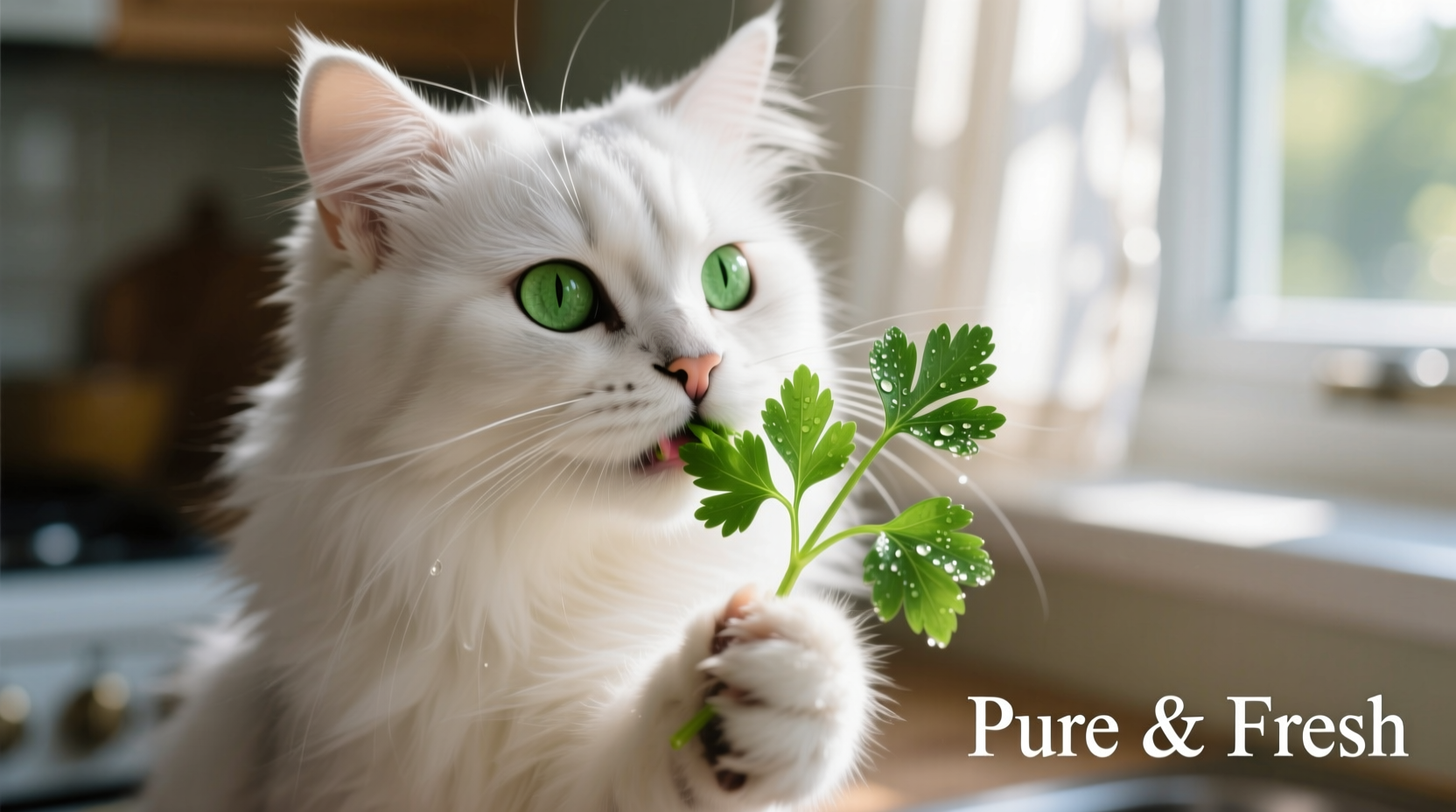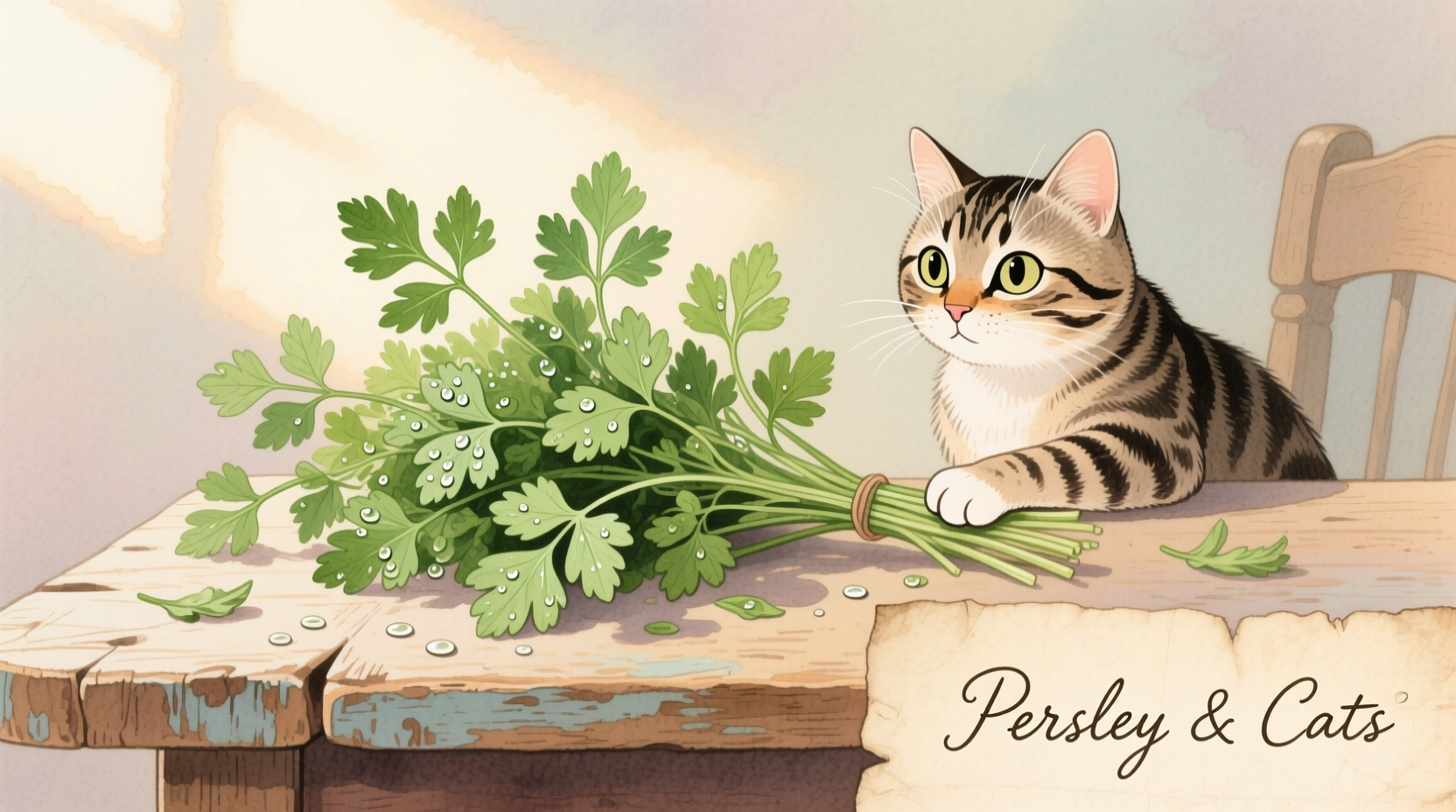Many cat owners notice their feline companions nibbling on parsley and wonder about its safety and potential benefits. As a plant that's commonly found in households, understanding parsley's effects on cats is important for responsible pet care. Unlike many other herbs and plants that are toxic to cats, parsley (Petroselinum crispum) is considered non-toxic by the American Society for the Prevention of Cruelty to Animals (ASPCA), making it one of the safer green options for curious cats.
Why Cats Are Drawn to Parsley
Cats often show interest in leafy greens like parsley for several natural reasons. This behavior, known as browsing, is instinctual and serves multiple purposes in feline health:
- Digestive aid - The fibrous nature can help with hairball elimination
- Nutritional supplementation - Provides trace nutrients not found in meat-based diets
- Natural behavior - Mimics grass-eating behavior observed in wild cats
- Dental health - Chewing on leaves may help clean teeth naturally
According to veterinary behaviorists, this plant-eating behavior is normal for approximately 71% of domestic cats, with parsley being among the preferred non-toxic options.
Parsley Safety Profile for Cats
| Plant | ASPCA Classification | Risk Level for Cats | Safe Amount |
|---|---|---|---|
| Parsley (fresh) | Non-toxic | Low | 1-2 sprigs weekly |
| Parsley (dried) | Non-toxic | Moderate | Small pinch monthly |
| Chives | Toxic | High | Avoid completely |
| Onions | Toxic | Severe | Avoid completely |
This comparison shows why parsley stands out as a relatively safe herb option compared to other common kitchen plants. The ASPCA's official stance confirms parsley's non-toxic status for cats, though they note that excessive consumption of any plant material can cause digestive upset.
Nutritional Benefits of Parsley for Cats
While cats are obligate carnivores requiring primarily meat-based diets, small amounts of parsley can provide supplementary nutrients:
- Vitamin K - Supports healthy blood clotting
- Vitamin C - Acts as an antioxidant (though cats produce their own)
- Chlorophyll - May help with natural breath freshening
- Dietary fiber - Aids in digestion and hairball management
Research published in the Journal of Feline Medicine and Surgery indicates that small amounts of plant material can complement a cat's digestive system, with the fiber content helping move hair through the gastrointestinal tract. However, these benefits only apply when given in appropriate quantities.
Safe Serving Guidelines for Cat Owners
When introducing parsley to your cat's environment, follow these evidence-based recommendations:
- Start small - Offer just one or two leaves initially to monitor reaction
- Fresh is best - Use organic, thoroughly washed fresh parsley (avoid pesticides)
- Limit frequency - Maximum 1-2 times per week
- Portion control - No more than 1-2 small sprigs per serving
- Observe reactions - Watch for vomiting, diarrhea, or unusual lethargy
Dr. Sarah Wooten, a veterinarian and contributor to the American Animal Hospital Association, notes: "While parsley isn't toxic to cats, it shouldn't be considered a dietary staple. The occasional nibble is fine, but cats get their essential nutrients from properly formulated cat food."

When to Avoid Parsley for Your Cat
Despite its generally safe profile, there are specific situations when parsley should be avoided:
- Kittens under 6 months - Their digestive systems are more sensitive
- Cats with kidney issues - Parsley contains compounds that may stress compromised kidneys
- Pregnant or nursing cats - Safety hasn't been established for reproductive health
- Cats on certain medications - Potential interactions with blood thinners
The Cornell Feline Health Center advises that cats with pre-existing medical conditions should avoid herbal supplements without veterinary approval. Always consult your veterinarian before introducing new elements to a cat with health concerns.
Parsley vs. Cat Grass: Understanding the Difference
Many cat owners wonder whether to offer parsley or cat grass. While both are generally safe, they serve different purposes:
- Parsley - Stronger flavor, more concentrated nutrients, should be given sparingly
- Cat grass (wheatgrass/oat grass) - Milder, specifically grown for cats, can be consumed in larger quantities
Cat grass is often preferred by felines and provides similar digestive benefits without the stronger flavor of parsley. Having both options available lets your cat choose what their body needs at any given time.
Preparing Parsley for Your Cat: Best Practices
If you decide to offer parsley to your cat, proper preparation is essential for safety:
- Choose organic parsley to avoid pesticide exposure
- Wash thoroughly under running water to remove dirt and contaminants
- Chop into small, manageable pieces (1-2 inches long)
- Offer fresh rather than dried (dried parsley is more concentrated)
- Monitor your cat for 24 hours after first introduction
Never add salt, oil, or other seasonings to parsley intended for cats. Plain, fresh parsley is the only safe option. Growing your own parsley ensures you control what goes into the plant, eliminating concerns about commercial pesticides.
Recognizing Problems: When Parsley Isn't Safe
While rare, some cats may have adverse reactions to parsley. Watch for these signs that indicate you should discontinue use:
- Excessive vomiting (more than once)
- Persistent diarrhea lasting over 24 hours
- Lethargy or unusual weakness
- Loss of appetite lasting more than a day
- Excessive drooling or difficulty breathing
If your cat shows any of these symptoms after consuming parsley, contact your veterinarian immediately. While parsley is non-toxic, individual sensitivities can occur, and other plants that look similar (like wild parsley varieties) may be harmful.
Alternative Safe Herbs for Cats
If your cat doesn't take to parsley or you want variety, several other herbs are considered safe in moderation:
- Catnip - Most cats love it, but only affects about 50-70% of cats genetically
- Valerian root - Similar effects to catnip for non-responsive cats
- Wheatgrass - Specifically grown as cat grass, excellent for digestion
- Mint - Peppermint and catnip are generally safe in small amounts
The key with any herb is moderation and observation. Each cat has unique preferences and tolerances, so what works for one may not suit another.
Final Recommendations for Cat Owners
Parsley can be a safe occasional treat for cats when provided in appropriate amounts. Remember these key points:
- Parsley is non-toxic but not nutritionally essential for cats
- Limit to 1-2 small sprigs once or twice weekly
- Always introduce new foods gradually
- Consult your veterinarian before offering to cats with health conditions
- Never replace balanced cat food with plant-based options
When in doubt about any food item for your cat, the ASPCA Animal Poison Control Center (888-426-4435) provides expert guidance. Responsible pet ownership means making informed decisions about what we share with our feline companions.











 浙公网安备
33010002000092号
浙公网安备
33010002000092号 浙B2-20120091-4
浙B2-20120091-4